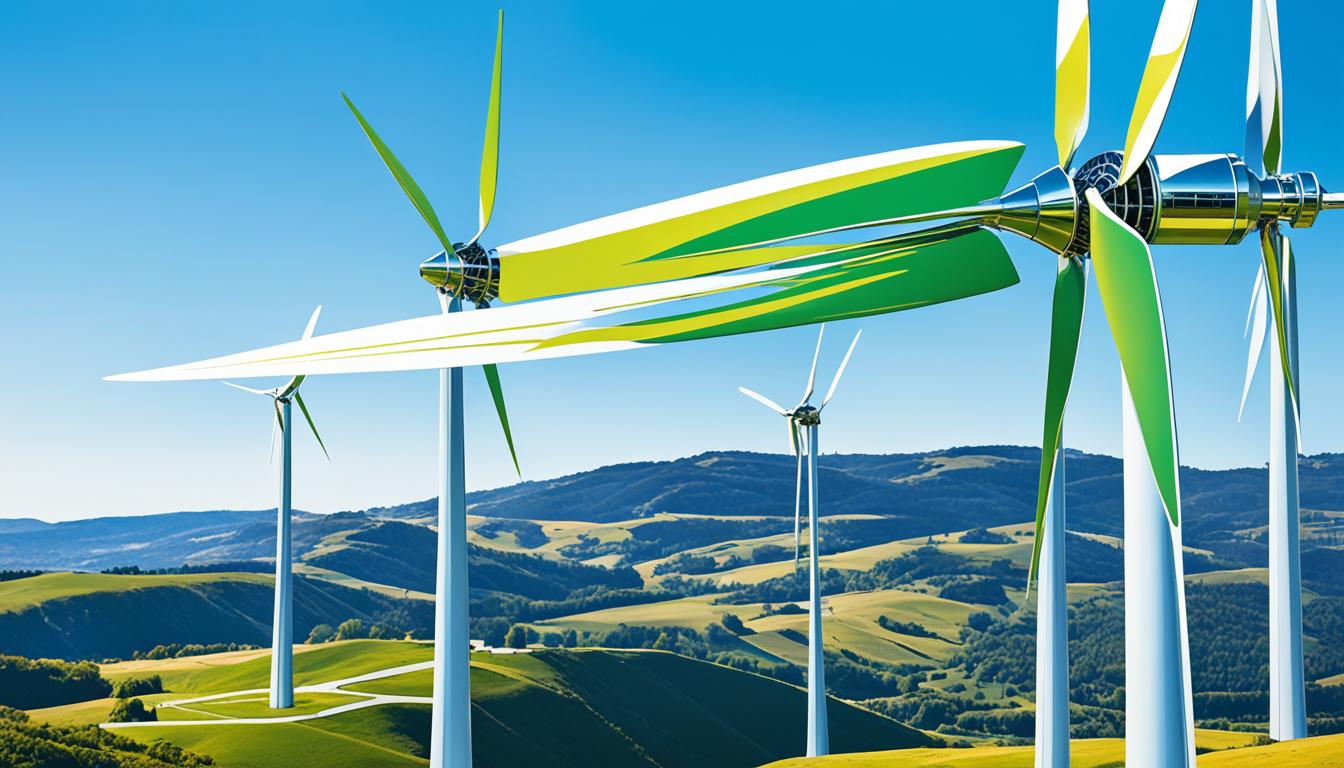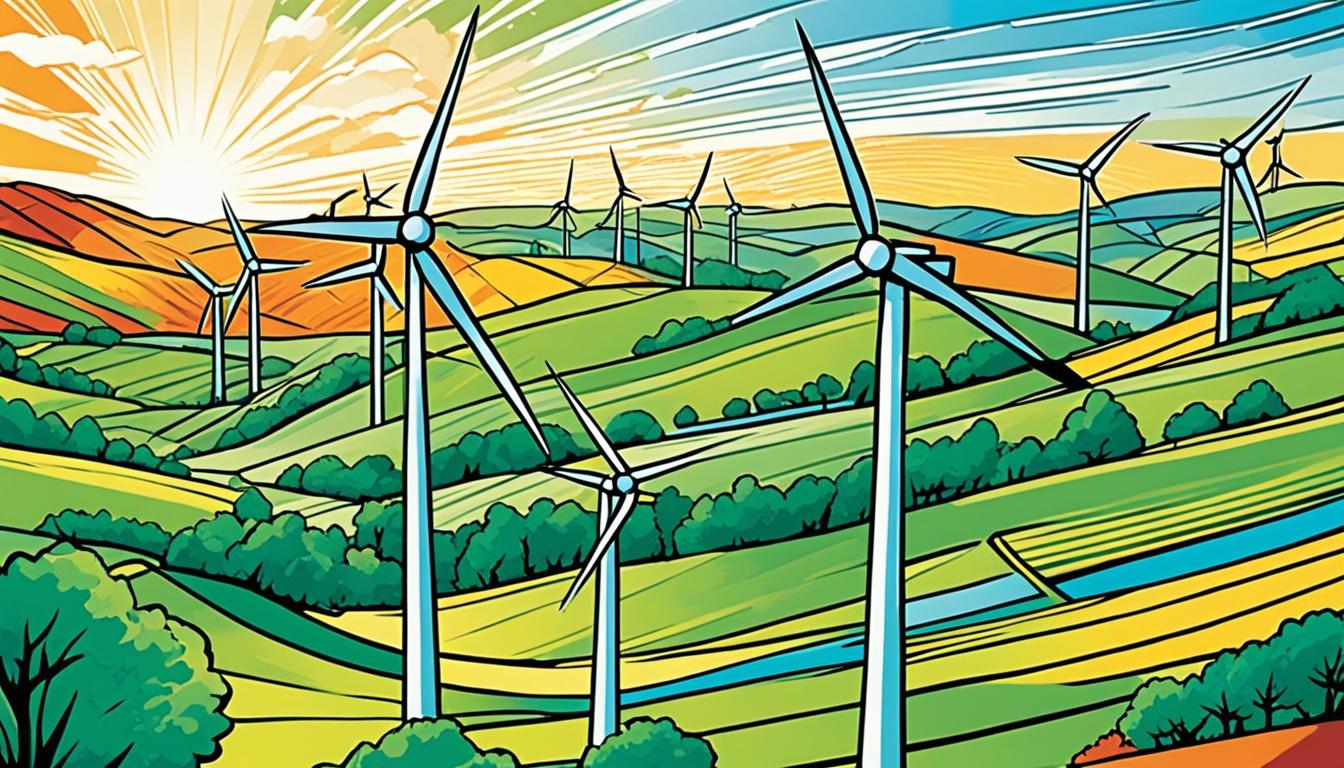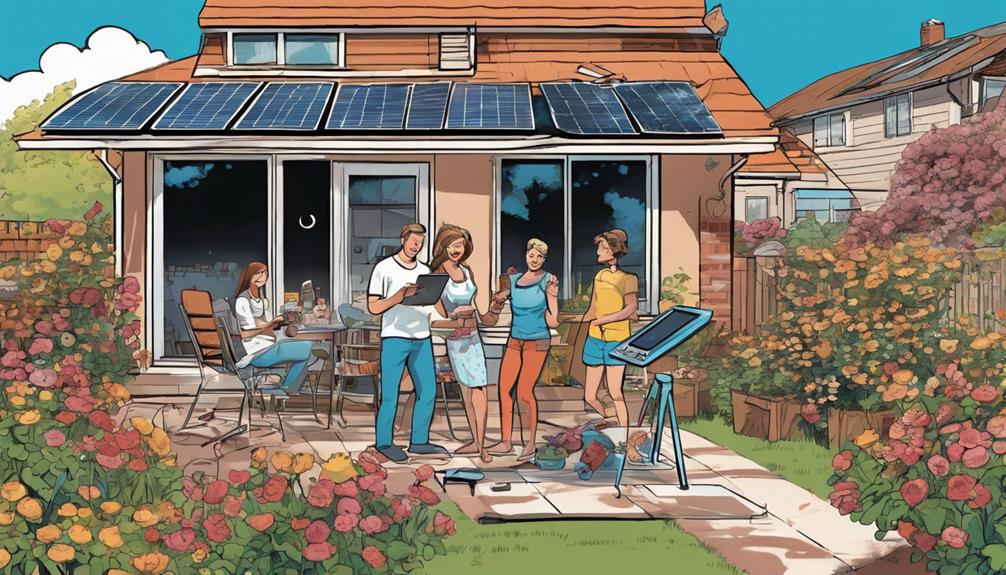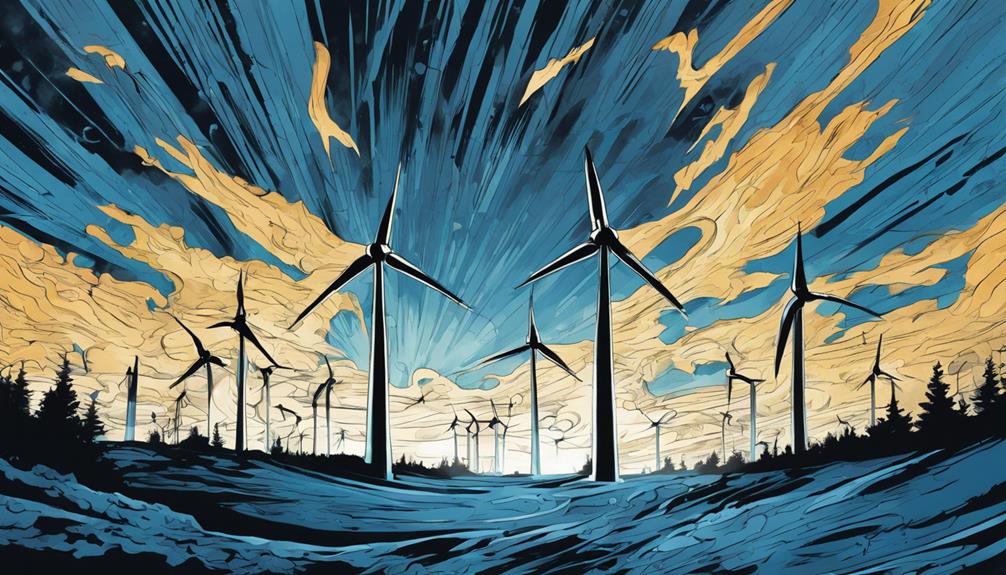Did you know wind turbines use the wind to make electricity? The speed and pattern of wind vary worldwide. This depends on vegetation, water bodies, and terrain differences1. Wind turbines are important for renewable energy. But, how do they work?
Wind turbines turn wind into electricity using forces from rotor blades. These blades rotate because lift forces are stronger than drag1. The wind’s kinetic energy makes the blades spin. This motion is then turned into electrical energy by a generator.
Wind turbines need wind speeds over 8 miles per hour to work. They turn off at speeds over 50 miles per hour to avoid damage1. The turbines have gearboxes. These gearboxes speed up the blade’s rotation, making electricity generation more efficient at slower winds1. Wind turbines vary, like AC induction systems, DC systems, and AC synchronous systems. They all use Faraday’s law of electromagnetic induction1.
Bigger wind turbines use induction and synchronous generators. Smaller ones use low-speed DC systems or Dynamos1. Generating electricity in turbines follows Faraday’s law of magnetic induction. It turns mechanical energy into electricity through electric current and magnetic flux1. This process involves coils or conductors, a magnetic setup, and motion between the field and the conductors1.
Knowing how wind turbines work helps us value the technology behind renewable energy. Next, we’ll explore more about wind turbines. We’ll look at their design, principles, and how they help our sustainable future.
Key Takeaways:
- Wind turbines harness the wind’s power to generate electricity, contributing to sustainable energy production.
- These turbines convert wind power into electricity using aerodynamic forces and rotor blades that rotate due to lift forces stronger than drag forces.
- Industrial wind turbines typically operate at wind velocities above 8 miles per hour, shutting off at over 50 miles per hour to avoid damage.
- Different types of wind turbine generators exist, including AC induction systems, DC systems, and AC synchronous systems.
- Key components of wind turbine generators include coils or conductors, magnetic fields, and relative motion for efficient energy production.
The Principle Behind Wind Turbine Generators
Wind turbines use wind energy to make electricity. They play a big part in creating clean, sustainable electricity. To understand how they work, we’ll look into the mechanics of wind turbine generators.
The rotor, with its blades, is the heart of a wind turbine. These blades catch wind energy. When wind hits the blades, it creates a pressure difference. This makes the blades spin and turns mechanical energy into electrical energy through a generator. This is how electricity is made.
Getting the most wind energy is key for wind turbines. By making rotor blades the right size and shape, wind turbines can turn wind’s kinetic energy into electricity efficiently. Interesting facts from2 show different sides of wind turbine generators:
| Statistical Data | |
|---|---|
| Wind turbines range in size from 100 kilowatts to several megawatts for land-based installations. | 2 |
| Offshore wind turbines are taller than the Statue of Liberty. | 2 |
| Horizontal-axis wind turbines are the most common type and typically have three blades pivoted upwind. | 2 |
| Vertical-axis wind turbines, including the Darrieus model, are omnidirectional and do not require adjustments to point into the wind for operation. | 2 |
These facts show the differences in wind turbine sizes, how tall offshore turbines are, and the various designs for efficient operation. They meet diverse energy needs in different environments.
Advancements in Wind Turbine Design and Efficiency
Over time, wind turbine design and technology have gotten better. These improvements help produce more electricity and work more efficiently. Let’s look at some key technological advances:
- A typical modern land-based wind turbine has blades over 170 feet (52 meters) long.
- Direct-drive turbines can reduce maintenance due to avoiding gearbox issues.
- The controller allows the turbine to start at wind speeds of about 7–11 miles per hour and shuts off at wind speeds exceeding 55–65 mph for protection against damage.
- The world’s first wind farm opened in New Hampshire in the US in 1980.
These improvements show the hard work to make wind turbines better, boost energy production, and support a sustainable future.
Understanding wind turbine generators helps us see their vital role in a greener, sustainable energy world. Next, we will learn more about the different kinds of wind turbines and their special features.
Types of Wind Turbines
There are two main kinds of wind turbines: horizontal-axis turbines and vertical-axis turbines. Each kind has its own special features and uses.
Horizontal-axis turbines are the ones you see most often. They are big machines with three blades that face the wind. These turbines can be as tall as 20-story buildings and have blades over 100 feet long3. Almost all wind turbines working today are this type3.
Vertical-axis turbines, on the other hand, are built differently. Their rotor spins around a vertical axis. This design means they don’t need to be moved to catch the wind. Their blades can be curved or shaped like eggs, making them small and flexible4.
Wind turbines can be set up on land or in the ocean. Turbines on land can do a lot of different jobs. They can power a single house or be part of a big power project. Turbines in the ocean are bigger and built to get the strong winds at sea4.
To sum it up, check out this table for the key points about horizontal-axis and vertical-axis turbines:
| Type of Wind Turbine | Design | Main Features |
|---|---|---|
| Horizontal-Axis Turbines | Rotor with three or more blades that spin around a horizontal axis | – Can be as tall as a 20-story building3 – Blades longer than 100 feet3 |
| Vertical-Axis Turbines | Rotor spins around a vertical axis | – Small and versatile design4 – Blades are helical or egg-shaped4 |
Choosing the right type of wind turbine depends on many things like location and what it will be used for. Both types have their own benefits and work best under certain wind conditions. Wind turbines are key in making clean, renewable energy to help our planet.
Applications of Wind Turbines
Wind turbines have changed how we make electricity, serving many energy needs. They’re found on land and at sea, showing that wind power is both reliable and green. Let’s look into how wind turbines are used and why they matter now.
Land-Based Wind Turbines
Most wind energy comes from land turbines. These range from small ones for homes to big ones for the utility grid. Wind power is the top source of renewable energy in the U.S., making up over 10% of the country’s electricity5.
A big 2.8-megawatt wind turbine can power about 100,000 homes5. These turbines get taller to catch more wind, which means more power. Plus, using wind to make energy cuts down on pollution. It’s better for our air, oceans, and whole environment5.
Offshore Wind Turbines
Offshore wind farms are becoming more popular because they can make more energy. The wind is stronger and steadier at sea6. Placed far from shore, these farms can power thousands of homes. They also help lower CO2 emissions6.
Distributed Wind Turbines
Small wind turbines go right where the power is needed. They help homes, farms, and small businesses make their own electricity. This is great for places far from the power grid, offering them a way to be more self-sufficient5.
Hybrid Systems
Hybrid systems mix wind turbines with other green energy sources. They work both off and on the grid. By combining wind with things like solar panels, these systems give steady power. This way, they make more energy, work better, and rely less on fossil fuels5.
Wind turbines have many uses, from big land projects to sea-based farms, small setups, and mixed systems. They bring affordable, green power, reduce bills, create jobs, and offer incentives. With support from places like the U.S. Department of Energy, wind energy is getting better and linking up smoothly with the power grid5.
Yet, there are issues to tackle, like wind power’s effects on health, safety, wildlife, and the environment5. Efforts are underway to lessen these impacts by studying wildlife and reducing turbine interactions. As technology improves, wind turbines are safer from cyber threats, reducing human impact and protecting our ecosystems56.
Wind Turbine Electricity Generation
In the last twenty years, we’ve seen a big jump in making electricity from wind7. This is thanks to better wind energy technology, which made it cheaper7. The U.S. government helped too, by offering incentives and programs for wind power7. Because of this, wind turbines now produce about 10.3% of the U.S.’s total electricity8.
Wind turbines can work both offshore and on land. Offshore ones do better because they’re in open water and can catch more wind7. In remote places, small turbines are part of systems that use batteries, diesel, and solar power. This helps make electricity better in those areas7.
Regular Maintenance for Effective Energy Production
Keeping wind turbines in good shape means they can make energy well7. A big problem can be too much shaking7. If the yaw system doesn’t work right, the turbines won’t be stable7.
They might also have issues with their voltage, cooling, or getting worn out by the wind and weather7. The care they need depends on where they are and their type. But good and regular checks can make them last longer and save money7. Having them well-maintained is key for making energy well and for their longevity7.
Electricity Generation Capacity
Wind turbines can make different amounts of electricity, based on their size and where they are9. Big ones for businesses can power over 450 homes a day9. Home turbines make less but still help9.
Big industrial turbines can make a lot more power9. How much they make depends on the wind and how big they are9. There are different kinds, and some are more efficient than others9.
Where they are is also important. The wind speed, how dense the air is, and having no blocks matter a lot9. Some can go really fast but have a limit to prevent damage. Bigger ones can adjust to match the power grid’s needs better than smaller ones9.
Wind Power Percentage in the United States
In the U.S., wind turbines make up about 10.3% of electricity8. This number is growing, but other sources like steam turbines and coal are still big contributors8. Steam turbines were the biggest source in 2022, making 42.5% of the electricity8.
Combined-cycle plants made about 34% of the electricity in 20228. Hydroelectric and solar PV plants also played a part8. Electricity storage is still a small part, but it’s there8.
Wind turbines are a big deal in making clean energy7. With new tech and government backing, wind power will keep growing7.
How Wind Turbines Connect to the Grid
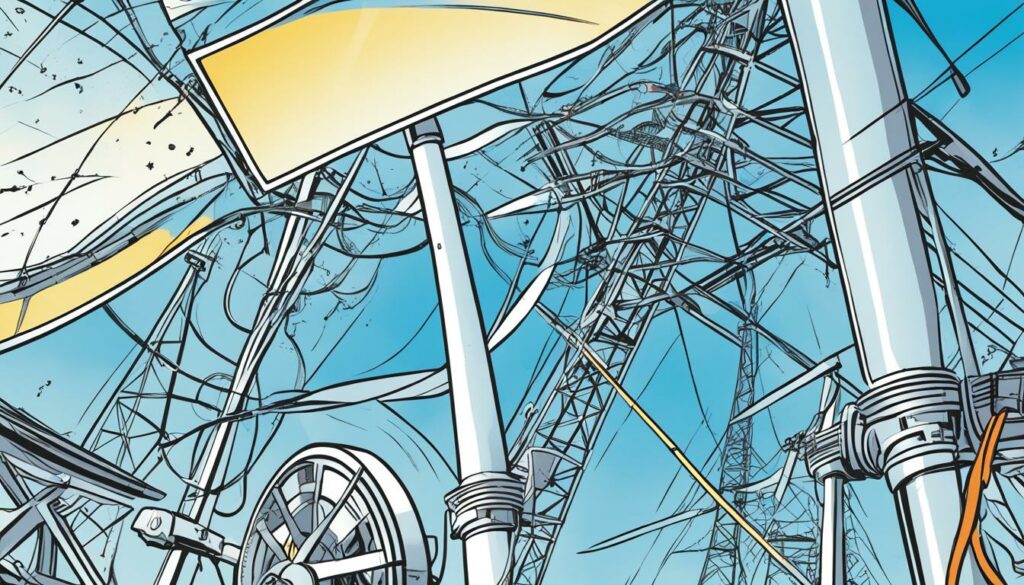
Wind turbines create electricity that we need to connect to the grid. This lets us share clean energy with more people. The connection to the grid involves important steps and parts for smooth integration.
Step 1: Voltage Transformation
First, the electrical energy from wind turbines is boosted in voltage by a transformer. This is needed so it can fit the grid’s standards. It also helps in sending the power efficiently.
Step 2: National Grid Connection
Once the voltage is right, wind turbine electricity is ready for the National Grid. This network spreads electricity across the country. It helps power homes, businesses, and industries everywhere.
Step 3: Distribution and Utilization
The wind-generated electricity, now in the grid, reaches various places for use. It powers homes, offices, and even factories. This helps reduce reliance on power sources that pollute more.
Wind farms or individual turbines can also make electricity for private use. This supports cleaner energy habits and helps cut down on pollution.
Notable Statistics
- The United Kingdom has about 23 gigawatts of wind-powered electricity on the grid, much more than nuclear10.
- In 2020, wind created about 25% of Britain’s electricity. This was second only to gas10.
- A single wind turbine can power 16,000 homes for a year10.
- The UK government is investing £160 million in offshore wind. This will provide electricity to every home by 203010.
- The Western Link cable moves power from Scotland to England with efficiency. This shares clean energy more widely10.
- Modern wind turbines stand up to various weather. They last for many years and work better10.
Connecting wind turbines to the grid helps cut carbon emissions. It supports a sustainable future with renewable wind power.
Wind Turbine Design and Visibility
Wind turbine design focuses on factors like color and how well they fit into the landscape. They are often painted white or pale grey to look better with their surroundings. This color choice helps the turbines to not stand out too much.
This color scheme follows the Federal Aviation Administration’s rules in the U.S., aiming for turbines to blend in11. Other places might have different rules for marking turbine blades.
The choice of white or pale grey makes turbines less noticeable against the sky and clouds. This is key for wind farms near the ocean11. Making turbines blend with nature lessens their visual impact, especially by the sea.
Wind turbine makers care about how they work and how they look. Lately, companies have made longer blades to catch more wind, thus generating more power11. For instance, GE Renewable Energy’s Haliade-X 13 can power a lot with its big area and 13 MW capacity in 202011.
Increased Efficiency through Wind Farm Array Design and AI
Efficient wind farm design takes a lot of planning and using AI. AI helps keep turbines working well and improves how wind farms are set up11. With AI, problems can be found early, reducing downtime and increasing power output.
Wind turbines are built to get the most energy from the wind. They have systems to adjust blade angles for best performance in various winds11. This ensures they work as efficiently as possible.
Horizontal-axis wind turbines (HAWTs) are the most common. They have three blades that turn wind into electricity11. These turbines have evolved, getting better at making power over time.
Ensuring Safety and Compliance
In the U.S., the Federal Aviation Administration sets rules to keep turbines safe and visible. This is crucial for farms near airports or flight paths12. It makes sure low-flying aircraft can see them.
Turbines are painted white to be easier for pilots to see. They also stand between 60 to 90 meters tall, aiding in their visibility12.
Wind turbines have changed how we generate renewable energy. They are built with care by companies like Vestas, GE, and Siemens Gamesa13. Rotor blades, key for capturing wind, are made from strong, light materials13.
The nacelle on top holds important parts like the generator and controls13. Gearboxes there face tough conditions and power the generator13. Turbines use special generators that transform spinning movement into electricity efficiently13.
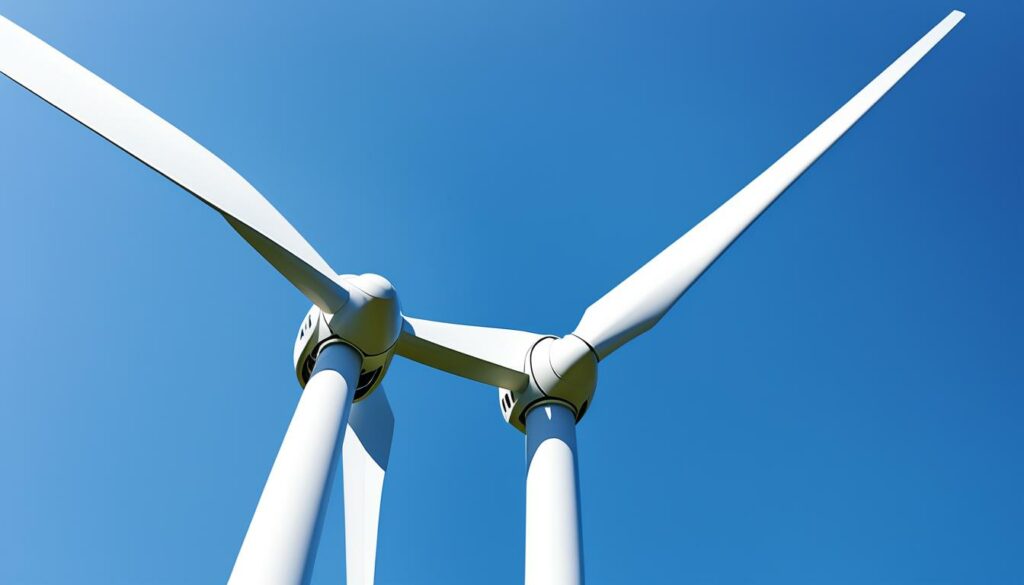
Wind turbines are smartly made to generate power well. Their control systems adjust many settings to get the most energy13. Special tech allows for smooth operation of control systems and generators13.
Safety is a big deal for turbines, especially because of lightning. Lightning protection directs the strike safely to the ground to prevent damage13.
By choosing certain colors and being mindful of rules, designers make turbines efficient and fit well in the landscape1112.
Wind Speed and Turbine Efficiency
Wind speed is key in deciding how well wind turbines work. They need to work within specific speeds, from 7mph to 56mph. This helps them use wind power well.
When the wind blows at about 18mph14, turbines do their best. They make the most power at this speed14. So, wind farms are usually set up where the wind is strong.
Different things affect a turbine’s efficiency. This includes the blade design, how fast they turn, and how well the generator works. On average, modern turbines are about 40% efficient14. This percentage comes from the blade and generator’s efficiency, which are 50%14 and 80%14 respectively.
It’s important for turbines to work well even when the wind is not very strong14. But, they also need to handle very strong winds, over 25 m/s14. Engineers keep trying new designs and materials to make turbines better at different wind speeds14.
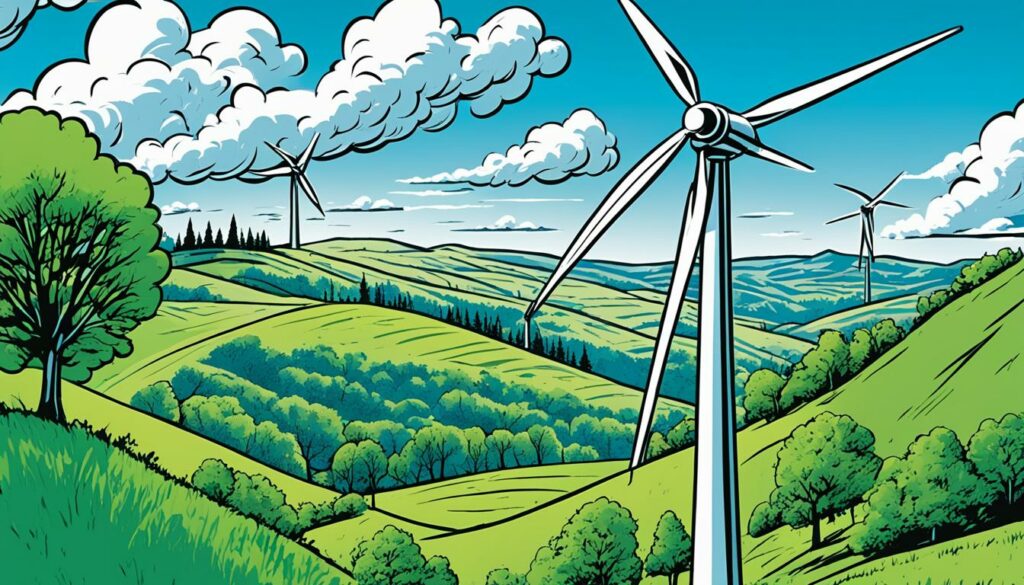
Knowing how wind speed affects turbine efficiency is essential. It helps make wind energy systems more efficient and affordable. This is crucial for creating more clean and sustainable energy worldwide.
The First Wind Turbine and Wind Farm
The journey into wind energy’s past reveals the birth of the first wind turbine and wind farm. These important events helped shape how we use wind power today.
In 1887, Professor James Blyth from Anderson’s College in Glasgow made the first wind turbine. This turbine, with its sails made of cloth, stood 10 meters high. It left a big mark on renewable energy15.
Over in the US, a big step was taken by Charles Brush in 1888. He built the first wind turbine in Ohio. This powered his mansion and was a big moment for generating electricity with wind15.
The wind energy field started to expand in the 20th century. The first wind farm came about in New Hampshire in 1980. Created by U.S. Windpower, it had 20 turbines16.
This wind farm was just the beginning. The UK saw its first commercial wind farm in Delabole in 1991. With 10 turbines, it opened a new chapter for renewable energy in the country16.
Denmark made its mark with the Vindeby offshore wind farm. It had 11 turbines and could power 2,200 homes a year. This farm showed the worth of offshore wind energy16.
The Blyth offshore wind farm started in 2003 in the UK. It was not only the UK’s first offshore wind farm but also the largest in the world at that time16.
Then in 2013, the University of Maine launched a floating wind turbine. This 20kW turbine was the first of its kind connected to the grid in the US. It set the stage for future offshore projects16.
Wind energy promises a cleaner planet. By 2050, it could cut 12.3 gigatonnes of greenhouse gases in the US. That’s like taking 1.3 million cars off the road. China will soon power more with wind and solar than coal. By 2030, the UK plans to have 50 gigawatts of offshore wind power. This shows major progress in using renewable energy16.
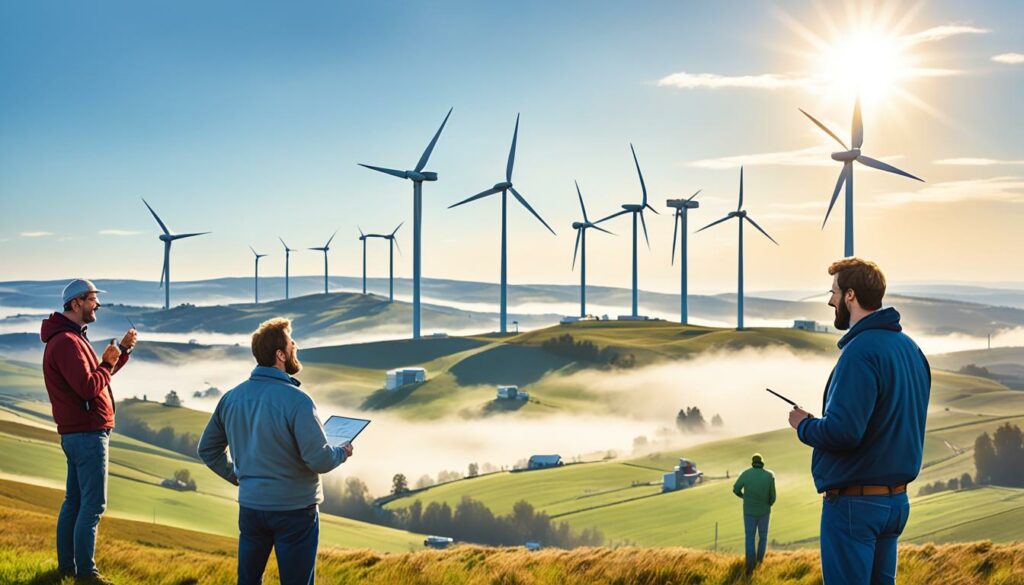
The creation of the first wind turbine and farm has pushed the wind energy field. As we move towards a renewable-powered future, these achievements highlight wind power’s endless promise.
Wind Turbines and Wildlife
Wind turbines help fight climate change by supporting renewable energy. Yet, their effect on wildlife, especially birds, can’t be ignored. Developers work with groups like the Royal Society for the Protection of Birds (RSPB) to protect bird numbers17.
Studies show wind turbines have a minor effect on birds compared to cats or buildings. Wind energy groups and RSPB try to reduce harm by avoiding habitat damage and collisions17.
When creating wind energy, the safety of birds, bats, and sea life is key. Developers check sites for their effect on these creatures. They use radar and cameras to keep an eye on birds and bats and change their plans to help at-risk species17.
Wind farm workers take steps to protect animals. They can slow turbines, use tech to keep animals away, and watch over the wildlife. They watch the area for a year after it starts working to see how birds and bats are doing17.
The combined effort between developers, groups, and scientists aims to reduce wind energy’s environmental harm. They use ongoing research and new technology17.
More research has helped us understand how different animals are affected. For example, large birds of prey don’t often die at wind farms, except at some places in California and Wyoming. Bat deaths do happen, but less often in the West18.
The number of birds near turbines and their actions help gauge risk. Places with more birds of prey see more deaths. Species like red-tailed hawks and golden eagles face higher risk due to their hunting habits near turbines18.
Most bat deaths happen in late summer and fall during migration, putting some species at more risk. Ground-nesting birds might stay away from turbines, seeing them as a threat. This is because predators could perch on the turbines18.
Wind turbines also indirectly affect animal homes. Their presence can disrupt breeding and nesting, particularly for birds that nest on the ground18.
When we think about wind turbines and the environment, we must also consider their emissions. Wind turbines emit between 0.02 and 0.04 pounds of CO2 per kilowatt-hour, much less than fossil fuels. Coal and natural gas produce much more CO219.,>
In summary, wind turbines boost green energy, but we mustn’t forget their impact on wildlife. By working together, developers, conservationists, and researchers strive to reduce harm to birds and other animals. They focus on careful monitoring, teamwork, and innovation171819.
Conclusion
Wind turbine generators are key to moving towards clean energy. They use wind to help us switch to sustainable energy sources. By the end of 2009, global wind capacity hit 160 GW20. Experts think wind energy will make up 8% of the world’s electricity by 2035 from just 1% in 200820. New technologies mean we can now build bigger wind turbines, between 1.5-5 MW20.
Wind power is great for the environment because it doesn’t create any pollution21. It’s also good for the economy. In the U.S., the wind industry provides jobs for over 125,000 people22. The U.S. Department of Energy believes this could reach 600,000 by 205022. Plus, the cost of wind energy has fallen by 74 percent since 200822.
The outlook for wind energy is bright. New technology and offshore wind farms are expected to help it grow21. Countries around the world are supporting this growth with policies and incentives21. By investing in wind energy, we’re taking steps towards a cleaner, sustainable future21.
